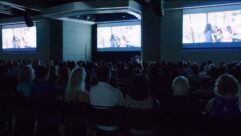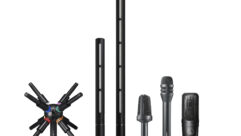
SVC Podcast – Show Notes – Show 154-1
In this special InfoComm edition of the SVC Podcast, SVC Contributing Editor Bennett Liles talks with Max Kopsho, Chairperson – Independent Consultants in Audiovisual Technology (ICAT) Council at InfoComm International and Principal Consultant focused on Unified Communications & Collaboration at Thornburn Associates. Max will be teaching the course Network Install and Support Fundamentals for IP Audio and Video along with Advanced Design and Programming Solutions for IP Audio and Video at InfoComm and he offers a preview of the topics to be covered.
Links of interest:
- The InfoComm Education and Show Planner
- How to Prepare for Your CTS-Installation (CTS-I) Exam
- Max Kopsho – Infocomm Bio
- The ICAT Council and Its Passion for Quality
Download Podcast Here:
https://s3.amazonaws.com/nb-svc/public/public/154-1_Max_Kopsho_IP_Audio_…
From Sound & Video Contractor Magazine, this is the SVC Podcast with Max Kopsho. Show notes for the podcast are on the web site of Sound & Video Contractor Magazine at svconline.com.
Networked AV used to focus on short bursts of control data but now there’s audio and video all over the network and for AV, everything has to be set up right to handle the traffic and to get it to the right place at the right time and in the right format. Max Kopsho will be at InfoComm with courses on how to handle that job with the latest technology. He’s here for a preview on the SVC Podcast.
Max, it’s always great to have you with us on the SVC Podcast and you’re going to be quite busy at InfoComm with at least two courses and recently invited to a third one. You’ll have Advanced Design and Programming Solutions for IP Audio and Video and Network Install and Support Fundamentals for IP Audio and Video. So far on the InfoComm podcasts we’ve had Managing Multiple AV Systems on the Network, Government Regulation and AV and now we’re taking on IP audio and video and that’s a lot so I know you’re going to be a busy guy there.
Yes, I am. And I think you for having me here. But I appreciate being busy. It’s a great show to be busy at and it’s really fun to be teaching at these shows. I think it’s self-serving because I also learn a great deal when I’m teaching at InfoComm, so I think it’s win-win. [Timestamp: 1:31]
And just getting into it, it may be that a large networked AV system can just look so impressive at the control end that what it took to properly design the whole system may not be as well appreciated. Isn’t it pretty easy to paint yourself into a corner if you don’t future proof this thing right?
Yeah, that is a great question because I think from a user standpoint – the beginning of your question – paints the picture because behind the scenes it is impressive at the control side. It gives us great flexibility and allows us, when it’s networked AV, to do a great deal more. It’s anything in/anything out, send video anywhere from anywhere and from a control standpoint that gives a great beauty to it, to everything’s IP-based so control is very simplified from a controlling standpoint. But it’s kind of hidden, as it should be, to the end user so there’s an added feature where from a design aspect the user should not really notice anything. From a future-proofing standpoint, though, we all kind of see that networking is the future. I mean it’s here today for everything else, and AV sees that and AV knows that that’s where it’s going. So the future-proofing standpoint really should be the networking side. So just knowing that as you’re incorporating networking it’s not only just because networking is everywhere and we kind of have to do it, it’s also knowing that you should be providing hooks into the expansion of the system, knowing you can increment your inputs and outputs simply by one – just by adding one more in point it’s a network node. So you can increase or increment your inputs and outputs by one whereas traditionally it requires the inputs to be done in four or eight or 16. Now there’s a beauty in future-proofing it where you can just do it by one. Also, the expansion of networked AV, you can add a functionality simply by adding a network appliance. So the future-proofing is there just by the nature of networking. [Timestamp: 3:33]
And it’s always a little bit of a guessing game depending on how far ahead you want to look but it’s all going to have to be run by people and we know that AV and IT hardware have become very integrated, but what about the people running it from both sides? What would be your advice on AV techs approach to working with the IT people?
One thing is that we have to look at what are our strengths already. So it’s looking at what your strengths, your weaknesses, where the opportunities are and what the threats are. I think our strengths are in analyzing what somebody’s pains are. So if we take that strength, we are really good in our industry of analyzing what their pains are. So taking that opportunity and analyzing somebody’s pain and walking through the needs analysis, we do that better than most any other industry. So the communications side we do really well. So if we take that and walk through what an IT person’s needs are, and then if we learn the language and understand the pains, so my recommendation is take that strength and learn the language and understand the pains and go through the problem solving that we do so well, then we have something there. I think we can do this portion, the AV, the networked AV side. We can do that better than anybody else. So my recommendation, again, to get to the root of your – what’s my advice? Take what we do really well and apply it to the networked AV side. [Timestamp: 4:51]
Well I think that historically in comparing the two, the people on the AV side of it may be more in tune with the users because we interact with them more frequently and that has trained us to be able to figure out what works for the individual user and what doesn’t.
I think you have a point, and that is it’s probably part of the answer to that question is the audio visual industry has a greater understanding of the user experience side. We create user experiences in many different industries. So the events side and other parts of our industry we really have a firmer grasp of the user experience side. Let’s take that strength and apply it in networked AV. [Timestamp: 5:37]
Yeah, and I think we get feedback from users more often and sometimes quicker than the IT network people. So what’s more important for AV technicians to know about IT networks, the hardware and the terminology?
I think IT networks, the hardware and the terminology – and there’s been a lot of buzz about this from writings in our industry right now and stuff, and I think we have to heed the warnings, is be very aware of security. And it’s not that we have to become security experts, it’s know our limits and lean on others who are experts and seek the guidance of those and become partners with those who are the experts and just be very aware of network security and how AV and network security have to work very closely together. That’s going to be the key. So any hardware that we’re working with that is audio visual and network together, we need to understand the security side of it and lean on those who know it very well. [Timestamp: 6:21]
Okay, and one of the courses, Network Install and Support Fundamentals for IP Audio and Video, you’re doing that on June 8th from 8:00 to 10:00 a.m. I believe it is. You take on the OSI model and that’s quite a challenge. You know, some AV people may have the notion that it’s sort of like requiring algebra for a fine arts degree. What do you tell them about the importance of the OSI model to AV?
And this is networked AV so there is a requirement in just about every networked course to have a basic understanding of the OSI model. It’s the basis for every communication over any network. So having a basic understanding of it just to know what communicates where within the OSI model – and it’s really just knowing at what level each device can communicate on and what layer of the OSI adds what value when. And then again, if I go back to the other question, what security concerns are at each level or what added features can be provided to us at each level. What efficiencies can be added at each level so when we apply AV to the OSI model, what benefits can we get out of switches, what benefits can we get out of routers, and why that happens is really within the OSI model. So let’s give an introduction to that in the fundamentals, and then the next course that we provide is, of course, the advanced level or the intermediate to advanced level. Then we can get down to more nitty-gritty information. But this one is just an introduction. I use a lot of analogies that kind of just make it an easy pill to swallow, but it is somewhat of a requirement to get that basic understanding. [Timestamp: 7:58]
Yeah, and I think that once you’ve worked in AV for a while a lot of this you can relate to your personal experience and it’ll kind of fall into place from that.
Yes, I absolutely agree and in the AV industry there was a day when we needed to know the hierarchy of analog video and you had to know what RGBHV was and then you had to know what RGBS was and some people would say that’s the same thing. It was teaching something that was a difficult concept to people who didn’t need to know that level of detail. It paid off in the end. Understanding that really paid off so that we could make our customers understand the value of going a little bit higher end when it went to providing video solutions. We want to do the same thing now that we’re talking about networked AV. [Timestamp: 8:37]
And one of the nice things about AV as compared to IT networks is that we have the opportunity to get a little more creative on the user interface where on the IT side, it’s often more of a one size fits all. So for us, how much should you know about the clients who will be operating the AV gear? Does that radically alter the design or the control methods used in the system?
I think this probably goes back to your other question about how much do we need to know about IT networks and the hardware and the terminology? If we know more about the products that are available to us in the industry, we can consult to our clients as long as we understand what they’re currently using. I think one of things that, as a consultative industry that is providing solutions to customers, we should almost never tell a customer, “This is what you have to do in order to use my product or solution.” Instead we should be saying, “What do you currently do and how can I give you a solution that will work within your current infrastructure?” So if we’re doing that, then yes, we do need to understand their operating system and we need to know how they currently work and then we seek out solutions from our industry, from our manufacturers and solutions providers that fit within our clients’ infrastructure. So absolutely we to understand how they’re currently doing things so that we can apply solutions that fit within their infrastructure. [Timestamp: 9:55]
Right. And I think that we sometimes have to be more familiar with the sophistication level of the clients, how button pushing friendly are they and at what point does it get too complicated.
Absolutely. I have a joking – I say it jokingly, but is our a client, a PhD, which means we’d need a PhD button which narrows down to “Push Here, Dummy.” You have to provide them that simple of a control system or they’re really techie. They like to have lots of buttons and they really just don’t want macros because they want to climb down that macro tree themselves. When Windows came out, it was really insulting to me because I would rather have a DOS prompt. Are they that kind of customer? So yeah, you’re absolutely right. You want to provide the user experience of what they’re comfortable with. [Timestamp: 10:36]
So when the people get there at InfoComm and you’re standing out there ready to go will these courses be completely lecture or will there be some hands-on stuff involved?
Oh, absolutely. There’s going to be some hands-on stuff because most of these courses are going to be taught in the computer labs InfoComm is providing. We are going to get to play with some of the code and some of the programming solutions and some of the equipment. So I think it’s going to have a nice balance of lecture and hands-on. I’m excited about the courses because we get to do a lot and learn a lot together. [Timestamp: 11:04]
Knowing which wires go where and going beyond to the wireless aspect of it. Then you take a look at security as you mentioned and possible interference between systems and the special challenges that come with going wireless.
And that’s what’s going to be great. We are going to have some wireless systems at InfoComm in this class and we’ll get to play with some of the challenges. Of course InfoComm, being a tradeshow, is going to be one of the most challenging environments so we will do some actual wired and wireless analysis in the class. That’s exactly it, is it’s a very wireless RF-rich environment so we’ll get to see all of these wireless networks stepping on each other and then the security aspects of wireless. So when and when we cannot do wireless within government applications and things like that are some of the topics that we’ll get to cover. [Timestamp: 11:49]
And wired or wireless, the clients still have to be able to use it easily or it gets left alone so how do you deal with the big challenge for AV in making it as simple as possible to use while still offering a full feature set?
I think, yeah, that’s going to be one of the challenges. We get to provide a challenge in the course and it’s one of those things where when you give a particular problem to a group of people, let’s say we’re going to have 60 people in the classroom and we’re going to break up into groups and they’re going to be on the computers, we’re going to issue a problem to them and I think we’re going to end up with 60 different solutions. It’s a blend of art and science and the artistic side is the solution is going to have 60 different beautiful solutions to it and the artistic side is that solution is going to be very unique. And it is solving a problem of who a particular customer and it’s really reading the customer in its iterative process. So it’s asking the customer was does this look like. And that’s why in our process for InfoComm and some of the standards that we set, we do a button-by-button process where we show them this is what it would look like in its iterative where that’s not the final solution because we asked them to kind of say is this what you were expecting and they give us some feedback. So we’re going to build that same kind of scenario in the class so as they build a networked AV control solution they see that it’s very much the same, that they’re going to design a system that creates a user experience that’s iterative and the customer has some say in, “I’m not real comfortable with that.” Each one is going to look a little different. [Timestamp: 13:12]
Yeah, another great thing about AV is that there is usually more than one right way to do it.
Yep. I love that part of our industry is that we get to be creative and just solve customer problems. [Timestamp: 13:23]
Alright, Advanced Design and Programming Solutions for IP Audio and Video, that’s Tuesday June 7th from 12:30 to 4:30 and Network Install and Support Fundamentals for IP Audio and Video on Wednesday June 8th from 8:00 to 10:00 a.m.
Yeah, and on Tuesday morning the technology trends I’ll be able to present an hour just during that general session of technology trends. [Timestamp: 13:45]
Wow. That’s a lot to do. You’re going to be a very busy guy at InfoComm.
Yeah. I’m looking forward to it though. And that’s for having me here.
Okay, it’s Max Kopsho with Thorburn Associates. I’ll bet you have standing room only at these events.
I’m hoping so. Thank you very much.
Thanks, Max.
Thanks for joining us for the SVC Podcast with Max Kopsho. Show notes are on the website of Sound & Video Contractor Magazine at svconline.com. Next week for Part 2 we’ll have Paul Zielie with his courses on Networked AV Systems, Network Traffic Analysis, AV/IT Security Needs Analysis and more. That’s on the next SVC Podcast.










